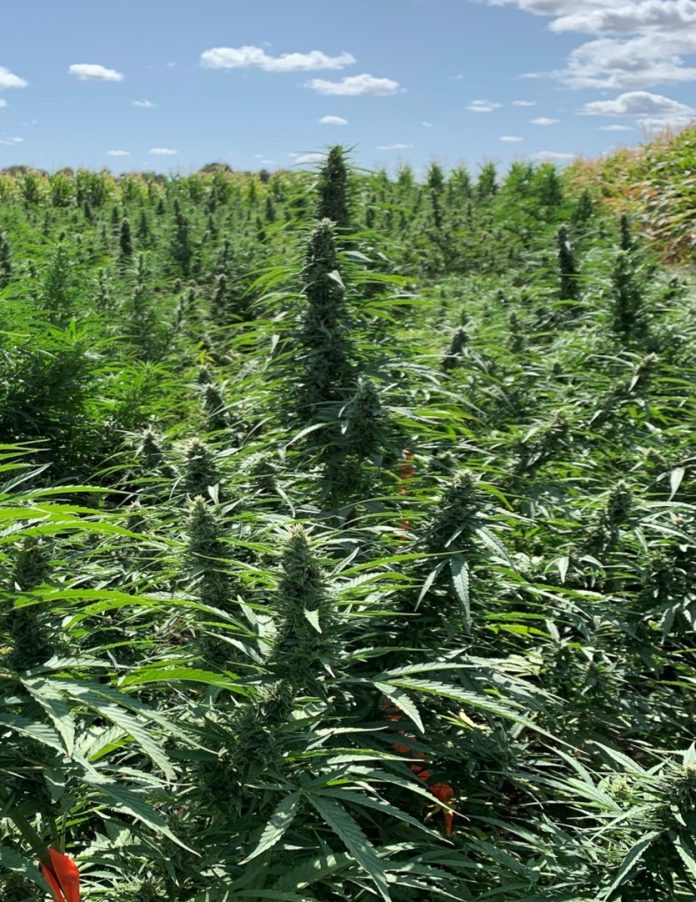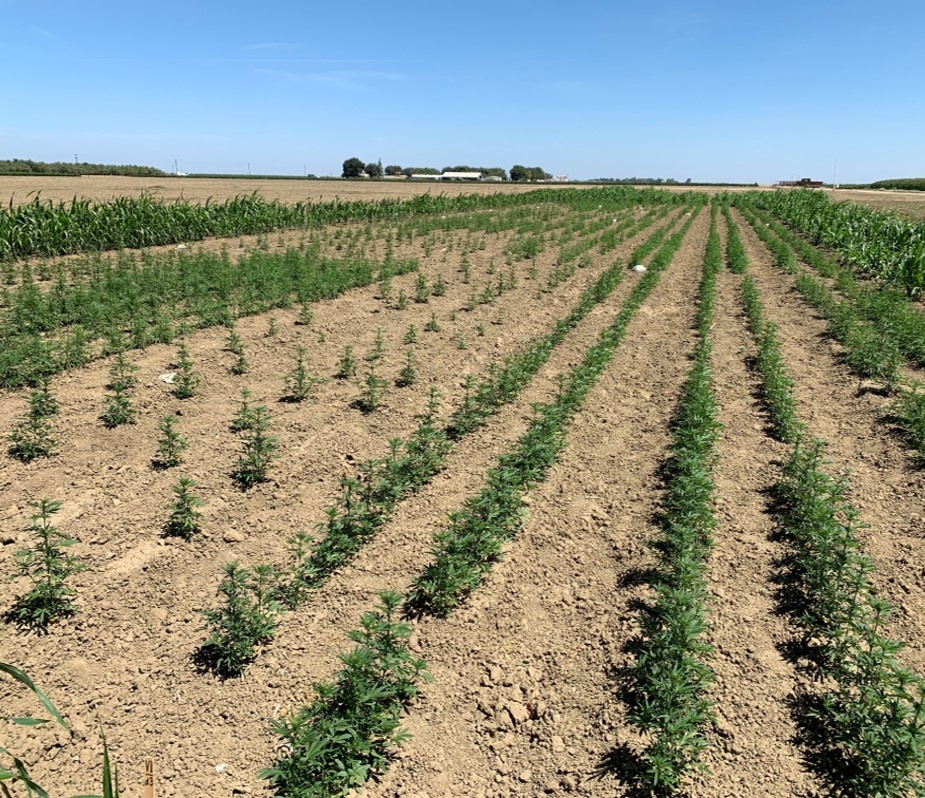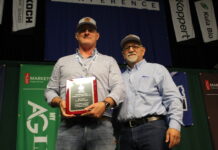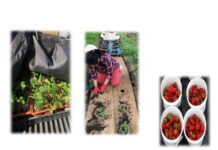
UCCE and UC Davis research efforts to understand the opportunities and challenges for industrial hemp production in California are growing.
As a crop relatively new to California growers and researchers, there is still much to learn about variety choices, how varieties and crop responses differ across regions with different soils and climates, best practices for nutrient management, and pest and disease issues.
Industrial hemp field research efforts began at the University in 2019 after the previous year’s Farm Bill declared the crop should no longer be considered a controlled substance, but rather an agricultural commodity. Hemp is valued for its fiber and edible seeds; however, in California, producing hemp primarily for essential oils, including medicinal cannabidiol (CBD), is thought to offer the best economic outlook. U.S. and California hemp acreage surged in 2019, but fell in 2020.
Hemp Water-Use Study Expands
In a study coordinated by Jeff Steiner of Oregon State University’s (OSU) Global Hemp Innovation Center, drip irrigation trials are underway in California, Oregon and Colorado. Research was conducted in 2020 at the UC West Side Research and Extension Center in Five Points and at the UC Davis campus in addition to three sites in Oregon, with an additional site in Colorado added in 2021. These studies were set up to determine water use of industrial hemp for CBD production under irrigation regimes ranging from about 40% to 100% of estimated crop water requirements, with comparisons of responses observed across the five sites with different soils, climate and other environmental conditions.
The study, funded by USDA and OSU, includes photoperiod-sensitive cultivars, where the flowering response is triggered by shortening day lengths in mid- to late summer in central California, and auto-flower varieties that do not require shortening day length to flower.
Some of the irrigation treatments impose moderate to more severe deficit irrigation to help assess the crop responses to water stress. Deficit irrigation is a method of conserving water by applying less than what might be considered optimum for maintaining rapid growth.
“This plant appears to be quite tough under deficit irrigation,” said UCCE Specialist Bob Hutmacher at the UC WSREC.
“We need to learn more about benefits and drawbacks to stressing the plants,” Hutmacher said.
The auto-flower cultivars tested tend to use less water than the photoperiod-sensitive cultivars because they can be grown in a shorter season. In the San Joaquin Valley, auto-flower cultivars in these studies were ready for harvest in 75 to 90 days after seeding.
“Water use is very variety-specific” Hutmacher said. “Auto-flower varieties may have potential to be grown in the spring and harvested by early summer, or planted in late summer and harvested before winter. With a short-season crop, and with a decent water supply, farmers could consider double-cropping with such varieties, potentially increasing profits.”
Yields were variable, but showed promise for auto-flower varieties.
“In our studies, the highest-yielding auto-flower cultivars have produced 80% to 90% of yields of the much larger full-season, photoperiod-sensitive plants, and some varieties may be equal,” he said.
Hemp Planting Density Studies
In cooperation with Kayagene Company of Salinas, Dan Putnam, UCCE forage crops specialist at UC Davis, and Hutmacher have conducted studies in 2019 and 2020 with two auto-flower varieties to determine the effect of plant density on crop growth, yield and chemical concentrations. Since some of the auto-flower varieties are smaller and earlier maturing than many photoperiod-sensitive cultivars, data in these studies will help determine the tradeoff between higher densities needed to increase yields versus increases in the cost of higher seeding rates.
A key concern for growers is producing a crop with economic levels of CBD or other compounds of commercial interest, while staying within regulatory limits for THC (tetrahydrocannabinol), the psychoactive compound found in marijuana, a related plant. According to CDFA, an industrial hemp crop grown in the state may have no more than 0.3% THC when plant samples are analyzed.
“This is a challenge for growers. You don’t want to risk too high a THC level,” Hutmacher said. “Farmers must test to make sure THC is at a level to meet regulations. If it’s too high, CDFA regulations would require the crop be destroyed.”

The studies provide opportunities for the scientists to assess plant-to-plant variation and impacts of flower bud position on THC and CBD concentrations. The data collected across a range of cultivars differing in plant growth habit may help better inform both researchers and regulatory groups in decisions regarding how to monitor plant chemical composition.
Hutmacher and Putnam are also working with commercial companies to test lines in the field, including Arcadia Biosciences in Davis, Phylos Biosciences in Portland and Front Range Biosciences in Salinas.
“There are a lot of challenges when it comes to estimating maturity with these varieties,” Putnam said. “Each variety will mature at different times, and deciding when is the best time is a key decision. We’re still learning about this issue.”
In 2021, in variety trials also coordinated by OSU’s Global Hemp Initiative Center, data will be collected from studies at up to 12 locations ranging from Oregon, Washington and California in the West to New York, Vermont and Kentucky in the eastern U.S. to compare varieties grown for CBD and other essential oils.
“Our participation in these multi-site trials is important in efforts to identify across very diverse environments and latitudes the plant response in terms of attained levels of CBD and THC,” Hutmacher said.
Launch of Hemp Fertilizer Project in 2021
As a new crop in California, little is known about crop nitrogen needs and application optimization to prevent environmental problems related to overuse. In 2021, a team of UC Davis researchers are launching a three-year nitrogen management trial supported by the CDFA Fertilizer Research Education Program (FREP). An important part of the project is THC and CBD analysis, a costly enterprise.
Three companies are providing seeds or clones for the project: Cultivaris Hemp of Encinitas, Kayagene of Salinas and Phylos Biosciences of Portland. Alkemist Labs of Garden Grove is donating services for analyzing crop samples.
“These are incredibly valuable donations to assist with this project, certainly in excess of $50,000 in donated materials and services from each of those companies,” Hutmacher said. The collaboration with the donors makes the development of environmentally sound nitrogen optimization information for growers possible together with the money provided by CDFA-FREP for the trials.


















